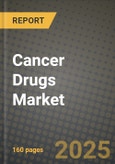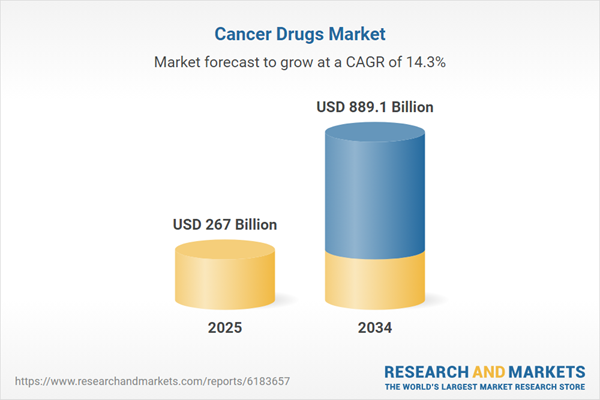Cancer Drugs Market
The Cancer Drugs Market encompasses targeted therapies, immuno-oncology agents, cytotoxics, hormonal therapies, supportive care, and emerging modalities that collectively aim to extend survival, improve quality of life, and shift treatment earlier in disease. The Cancer Drugs Market is shaped by precision medicine: tumor profiling, minimal residual disease (MRD) monitoring, and liquid biopsy direct therapy choice, combinations, and sequencing. Top applications include solid tumors (lung, breast, colorectal, prostate, liver, ovarian) and hematologic malignancies (leukemias, lymphomas, myeloma), with rising use of neoadjuvant and adjuvant regimens that pursue pathologic complete response and recurrence reduction. Trends feature next-generation targeted inhibitors against resistance mutations, bispecific antibodies, antibody-drug conjugates (ADCs) with optimized payloads and linkers, cell therapies expanding beyond hematology, and checkpoint backbones paired with costimulatory or metabolic agents. Drivers include aging populations, earlier screening and diagnosis, payer willingness to reimburse high clinical value, and accelerated regulatory pathways contingent on confirmatory outcomes. Competitive intensity centers on first- and best-in-class differentiation, line-of-therapy positioning, companion diagnostic integration, and real-world evidence to expand labels and justify value-based contracts. Barriers remain: trial complexity, access disparities, toxicity management, manufacturing constraints for biologics and cell therapies, and policy scrutiny on affordability. Commercial models evolve toward indication-based pricing, outcomes-linked agreements, curated pathways, and digital adherence support. Looking ahead, advantage will accrue to portfolios that deliver durable benefit with manageable toxicity, demonstrate utility across biomarker-defined populations, and coordinate end-to-end - from diagnostic identification through therapy initiation, adverse-event stewardship, and longitudinal survivorship - supported by robust data and reliable global supply.Cancer Drugs Market Key Insights
- Precision and biomarker stewardship now decide market share
- Combination architecture is the new product strategy
- ADCs and bispecifics rewire the efficacy-tolerability frontier
- Cell and gene therapies push beyond hematology
- Access is shaped by value frameworks and real-world evidence
- Toxicity management is commercial strategy, not just medicine
- Manufacturing agility underwrites launch and growth
- Diagnostics-drug-data ecosystems compress time to treat
- Digital adherence and care orchestration drive outcomes
- Policy and affordability pressures require proactive design
Cancer Drugs Market Reginal Analysis
North America
High adoption of genomic profiling, strong clinical trial infrastructure, and broad access to innovative regimens drive early uptake; payer scrutiny channels use through step edits, prior authorization, and outcomes contracts, while integrated delivery networks emphasize pathway adherence, toxicity stewardship, and specialty-pharmacy coordination to manage total cost of careEurope
Centralized health technology assessments and price-value negotiations shape launch cadence and indication breadth; national tumor boards, guideline harmonization, and robust real-world registries support evidence-based adoption, with increasing preference for combination strategies that demonstrate clear incremental benefit and manageable budget impactAsia-Pacific
Rapid capacity growth in oncology centers, expanding reimbursement, and domestic innovation pipelines accelerate access; large incident populations enable swift enrollment and real-world data generation, while variability in testing infrastructure and funding drives tiered portfolios, local partnerships, and patient-assistance models to reduce time from diagnosis to therapy startMiddle East & Africa
Centres of excellence in major cities expand access to advanced biologics and targeted therapies, supported by government procurement and private insurance; constraints in molecular testing and infusion capacity spur hub-and-spoke models, with emphasis on guideline adoption, pharmacist-led adherence programs, and reliable cold-chain for temperature-sensitive productsSouth & Central America
Public-private mix influences uptake, with leading cancer institutes piloting novel regimens and broader systems adopting as budget permits; access strategies combine named-patient use, tiered pricing, and diagnostic partnerships, while supply continuity, clinician education, and navigation services are prioritized to improve adherence and reduce treatment discontinuitiesCancer Drugs Market Segmentation
By Type
- Chemotherapy
- Targeted Therapy
- Immunotherapy
- Hormonal Therapy
- Others
By Application
- Blood Cancer
- Breast Cancer
- Gastrointestinal Cancer
- Prostate Cancer
- Respiratory/Lung Cancer
- Others
Key Market players
Roche (Genentech), Novartis, Bristol Myers Squibb, Merck & Co. (MSD), Pfizer, AstraZeneca, Johnson & Johnson (Janssen), Eli Lilly, Amgen, GSK, Sanofi, Takeda, Bayer, AbbVie, Gilead Sciences, Daiichi Sankyo, Astellas Pharma, BeiGene, Eisai, SeagenCancer Drugs Market Analytics
The report employs rigorous tools, including Porter’s Five Forces, value chain mapping, and scenario-based modelling, to assess supply-demand dynamics. Cross-sector influences from parent, derived, and substitute markets are evaluated to identify risks and opportunities. Trade and pricing analytics provide an up-to-date view of international flows, including leading exporters, importers, and regional price trends.Macroeconomic indicators, policy frameworks such as carbon pricing and energy security strategies, and evolving consumer behaviour are considered in forecasting scenarios. Recent deal flows, partnerships, and technology innovations are incorporated to assess their impact on future market performance.
Cancer Drugs Market Competitive Intelligence
The competitive landscape is mapped through proprietary frameworks, profiling leading companies with details on business models, product portfolios, financial performance, and strategic initiatives. Key developments such as mergers & acquisitions, technology collaborations, investment inflows, and regional expansions are analyzed for their competitive impact. The report also identifies emerging players and innovative startups contributing to market disruption.Regional insights highlight the most promising investment destinations, regulatory landscapes, and evolving partnerships across energy and industrial corridors.
Countries Covered
- North America - Cancer Drugs market data and outlook to 2034
- United States
- Canada
- Mexico
- Europe - Cancer Drugs market data and outlook to 2034
- Germany
- United Kingdom
- France
- Italy
- Spain
- BeNeLux
- Russia
- Sweden
- Asia-Pacific - Cancer Drugs market data and outlook to 2034
- China
- Japan
- India
- South Korea
- Australia
- Indonesia
- Malaysia
- Vietnam
- Middle East and Africa - Cancer Drugs market data and outlook to 2034
- Saudi Arabia
- South Africa
- Iran
- UAE
- Egypt
- South and Central America - Cancer Drugs market data and outlook to 2034
- Brazil
- Argentina
- Chile
- Peru
Research Methodology
This study combines primary inputs from industry experts across the Cancer Drugs value chain with secondary data from associations, government publications, trade databases, and company disclosures. Proprietary modeling techniques, including data triangulation, statistical correlation, and scenario planning, are applied to deliver reliable market sizing and forecasting.Key Questions Addressed
- What is the current and forecast market size of the Cancer Drugs industry at global, regional, and country levels?
- Which types, applications, and technologies present the highest growth potential?
- How are supply chains adapting to geopolitical and economic shocks?
- What role do policy frameworks, trade flows, and sustainability targets play in shaping demand?
- Who are the leading players, and how are their strategies evolving in the face of global uncertainty?
- Which regional “hotspots” and customer segments will outpace the market, and what go-to-market and partnership models best support entry and expansion?
- Where are the most investable opportunities - across technology roadmaps, sustainability-linked innovation, and M&A - and what is the best segment to invest over the next 3-5 years?
Your Key Takeaways from the Cancer Drugs Market Report
- Global Cancer Drugs market size and growth projections (CAGR), 2024-2034
- Impact of Russia-Ukraine, Israel-Palestine, and Hamas conflicts on Cancer Drugs trade, costs, and supply chains
- Cancer Drugs market size, share, and outlook across 5 regions and 27 countries, 2023-2034
- Cancer Drugs market size, CAGR, and market share of key products, applications, and end-user verticals, 2023-2034
- Short- and long-term Cancer Drugs market trends, drivers, restraints, and opportunities
- Porter’s Five Forces analysis, technological developments, and Cancer Drugs supply chain analysis
- Cancer Drugs trade analysis, Cancer Drugs market price analysis, and Cancer Drugs supply/demand dynamics
- Profiles of 5 leading companies - overview, key strategies, financials, and products
- Latest Cancer Drugs market news and developments
Additional Support
With the purchase of this report, you will receive:- An updated PDF report and an MS Excel data workbook containing all market tables and figures for easy analysis.
- 7-day post-sale analyst support for clarifications and in-scope supplementary data, ensuring the deliverable aligns precisely with your requirements.
- Complimentary report update to incorporate the latest available data and the impact of recent market developments.
This product will be delivered within 1-3 business days.
Table of Contents
Companies Mentioned
- Roche (Genentech)
- Novartis
- Bristol Myers Squibb
- Merck & Co. (MSD)
- Pfizer
- AstraZeneca
- Johnson & Johnson (Janssen)
- Eli Lilly
- Amgen
- GSK
- Sanofi
- Takeda
- Bayer
- AbbVie
- Gilead Sciences
- Daiichi Sankyo
- Astellas Pharma
- BeiGene
- Eisai
- Seagen
Table Information
| Report Attribute | Details |
|---|---|
| No. of Pages | 160 |
| Published | November 2025 |
| Forecast Period | 2025 - 2034 |
| Estimated Market Value ( USD | $ 267 Billion |
| Forecasted Market Value ( USD | $ 889.1 Billion |
| Compound Annual Growth Rate | 14.3% |
| Regions Covered | Global |
| No. of Companies Mentioned | 20 |









